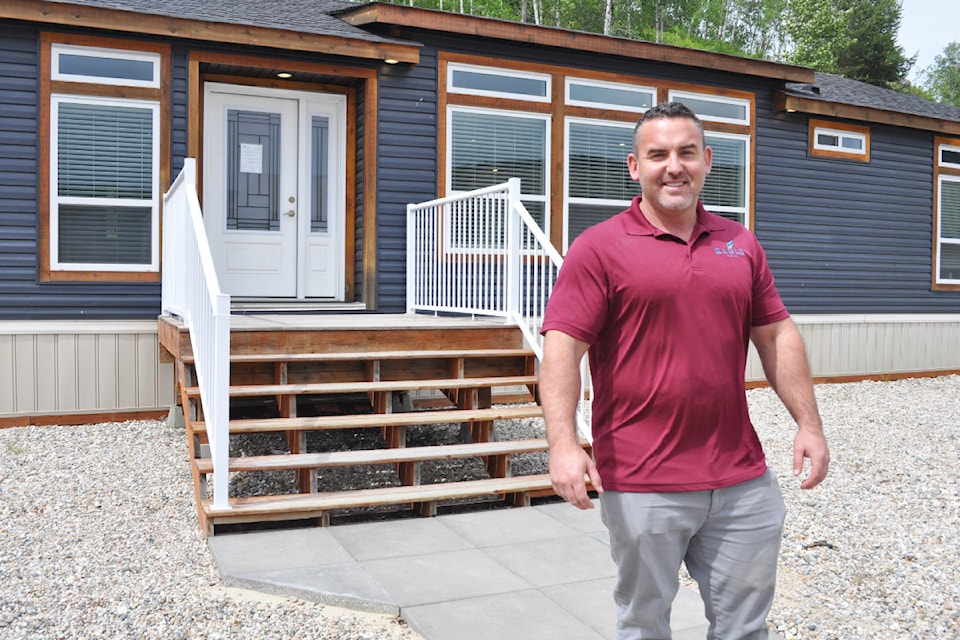When he was a contractor, Ryan Dore never cared much for modular homes.
He thought they were just fancy trailers, a fresh coat of paint on cheap, poorly built homes that were no longer in fashion.
But that was before he stepped into a modern modular build, and realized what they might mean for B.C.’s housing crisis.
“Everyone knows we have a lack of trades and costs of housing have just gotten out of control for every Canadian,” says Dore, who now works as a consultant in Castlegar with Eagle Homes, which builds and sells custom modular housing. “So we need more efficient, better ways to build.
“This is a way better way to build.”
For a traditional stick-built home, construction is entirely on-site, involves multiple companies, and can be delayed by changing costs, supply chain issues, the availability of tradespeople and even weather.
Eagle Homes, by contrast, builds its units to near completion in a factory before delivering to the owner’s land where the finishing touches are made. The company's staff build the homes using its own supply stock.
Once a customer picks a home size, which range between 500-2,000 sq. ft, and decides on customizations, Dore says the home can be built in just three-to-four months at a price that’s 10-20 per cent less a similar stick build.
“We’ve been building the same way for 400 years and it’s super inefficient, with ridiculous amounts of material waste.”
B.C. is in desperate need of housing. In a report released last September, the Canada Mortgage and Housing Corporation (CMHC) estimated the province — in addition to the current units being constructed annually — to meet demand and lower prices to 2004 levels.
The NDP government has responded to the housing crisis with legislation meant to increase density in most communities. As of July 1, developers can build three-to-six units on lots zoned for single-family homes and duplexes in any municipality with populations of 5,000 or more.
But the legislation only targets creating 130,000 units over the next 10 years, well short of the CMHC estimate.
Modular housing, however, could help make up the difference.
Keith Herring, director of modular and construction systems with the Canadian Home Builders’ Association, estimates just eight-to-nine per cent of all units in development across Canada are either modular or have some factory-built component.
That percentage, he says, will rise over the next decade as labour shortages, rising investment and public interest in affordable construction methods coalesce.
“This is the most interest there’s ever been in modular and factory built [homes.] So anecdotally, it just feels like we’re at the precipice of moving forward.”
At least one of the West Kootenay’s major employers is already jumping into the modular market.
Last month, the provincial government announced into the construction of a new Kalesnikoff Timber facility based out of Castlegar that will create modular buildings using mass timber as well as 100 new jobs.
Chief operating officer Chris Kalesnikoff said modular buildings will account for up to 50 per cent of the new business, while prefabricated components will also be made. The company’s 2019 move into mass timber meant it already had the tech in place to start designing for modular projects.
“A lot of the construction methods are still the same. When we’re doing some of our structural walls, you’re still taking a nail gun and nailing two-by-six together. So it’s really all that digital upfront technology that’s going to allow these products to be faster, better and still be affordable.”
The company will focus on large-scale projects, which Kalesnikoff said is more efficient rather than building single, customized homes. Kalesnikoff Timber is currently working on its first contract for a 120-unit modular workforce development that will be delivered to Montana.
There’s already an example in Nelson of what such a project might look like. Modular units were used to create at Selkirk College’s Silver King Campus, which opened in March. The college will complete another student housing development at its Castlegar campus ahead of the fall semester using modular units fabricated by Alberta-based ROC Modular.
Modular construction is also being used to solve classroom crowding in B.C.'s public schools. The Ministry of Education announced last fall that eight school districts would receive 104 new classrooms built as prefabricated additions to existing schools. None of those schools are in the Kootenays, but a ministry spokesperson told the Nelson Star it plans to announce more expansion projects in the weeks to come.
Kalesnikoff isn’t sure that modular building will ever replace on-site construction, but he does believe it will be a market for customers in need of affordable homes.
“I think it will definitely continue to grow in popularity just because there is such a shortage and we can’t continue to do things the same way that we are right now.”



